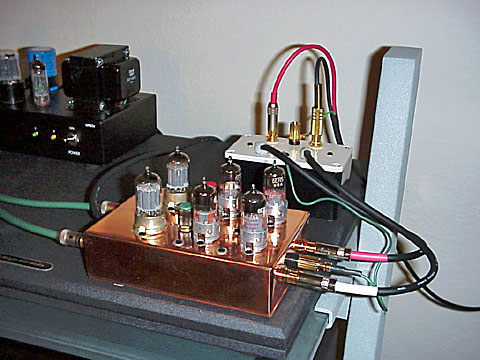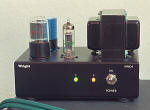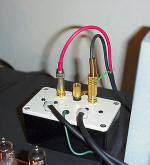-edible zone-
Review: Wright Sound Company WPP100C Phono Preamp
Date:
11/11/2002
Author: user510
Model: WPP100C
Category: Phono
Preamp
Suggested Retail Price: $825 for the preamp / power supply +
$250 for the WPM100 MC step up transformer
Description: Phono preamp
and separate power supply with additional MC step-up (three pieces)
Manufacturer URL:
http://www.wright-sound.com/ (no longer available)
Model
Pictures:
*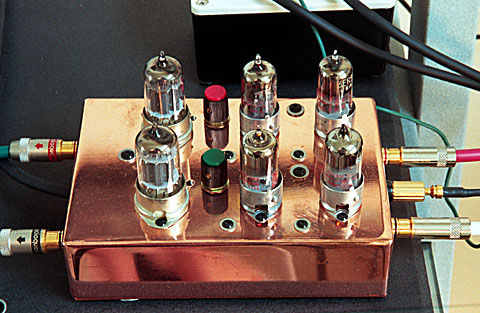
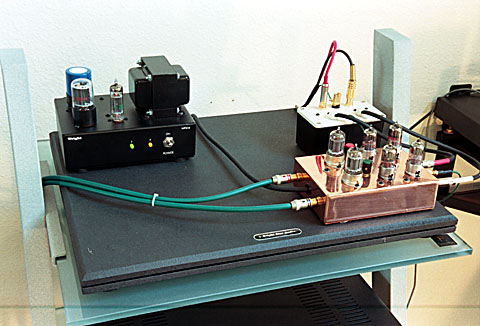
This review could be considered as integral to the Teres model 135
turntable review I've done previously as this phono preamp is the latest
addition to the audio system incorporating that turntable.
Searching for a suitable phono stage for my audio system to match the
needs of the Shelter 501 type 2 cartridge I'd recently added, I left an
email message at George Wright's website. A day later I had a phone call
from George logged onto my telephone answering machine. With no further
phone tag, I was able to contact George by phone and talk about getting
one of his units to try out on my system. George suggested that I could
buy the product on a 15 day full refund trial period. I arranged to pick
up the components in a few days. Now that these have been in my system
for over a week, I have the following thoughts below.
The Wright
WPP100C is a vacuum tube phono preamplifier with a compliment of 6
vacuum tubes on the preamplifier as follows: Zenith 6ER5/EC95 (four) and
Zenith 5963/12AU7A (two). There is a maximum gain of 65 db adjustable
via left and right control knobs located on top of the unit amidst the
tubes. The chassis is solid copper alloy. According to George Wright,
this is said to offer increased/enhanced grounding and contributes to
the units' low background noise. RCA jacks input end and output end are
of the gold plated variety. The ground stud is also gold plated and is
substantial.
The power separate power supply, part no.# WPS04, is
included in the cost of the preamplifier and also uses a pair of vacuum
tubes. The rather large looking transformer sits atop the black box
imparting a very retro look to the whole affair. There are two LED's on
the side of the black box next to the power on toggle switch. The Green
LED, labeled "F" lights up immediately when power is switched on. The
second yellow LED, labeled "P" appears in a 15 to 20 second delay when
the unit is fully powered up and ready to play. The vacuum tubes begin
to show light as soon as the "P" LED is lit. This circuitry is intended
to increase tube life.
Because I use a moderately low output
moving coil phono cartridge, a Shelter 501 type 2, a step-up transformer
is needed for impedance matching and voltage step-up going into the
Wright phono preamp. This device is pn# WPM100, manufactured by Wright,
and is claimed to match impedance with cartridges needing an ohm load
from 2 ohms to 100 ohms. The step-up ratio is 1:10. This should meet the
needs of the Shelter which is rated by its manufacturer to operate at a
100 ohm load and a voltage output of .4mv. The cost of the step-up
device is $250 in addition to the preamp. This device allows the preamp
to operate at moderate gain levels where background noise will be the
quietest.
In my system there has been no evidence of hum or any
grounding issues associated with the use of the Wright WPP100C. I've
found that setting gain via the control knobs on the WPP100C at roughly
one-third of the range will match the output of my other front end
components in the system. Turning the gain up into the one-half region
will result in a more forceful, aggressive output on this system.
Now, on to the sound.
In the owners operating guide, the
performance of the unit is described as having "extremely fast transient
response, sonically neutral, with no added coloration". What I've heard
from the Wright WPP100C will confirm these claims.
In general I
would describe the sound of the Wright as having articulate, fast
transients while preserving delicacy and detail. There is no sonic
coloration that I can detect, but rather the unit reproduces a natural,
fully timbred, rich and revealing presentation of each instrument and
voice. I've also discovered a pronounced aliveness to the sound.
Reverberant passages evoke strong ambiant* sensations. Dynamics are fast
and explosive. Rapid, dense musical passages are fully detailed.
Example: Moody Blues "In Search of the Lost Chord", "Departure". This is
the intro into "Ride My See Saw" that features a synthesizer tone rising
in pitch in a seemingly endless linear climb ultimately reaching a
climactic crescendo at the end. This manages to raise the hairs on the
nape of my neck repeatedly...! So far three times in a row. I like it
when that happens.
The midrange is reproduced natural and alive.
Vocals are natural and richly detailed. Highs are rendered fully and
even impossibly fine detail is reproduced in a delicate sharpness. Bass
reproduction is terrific with deep, extended, large, round, full low
frequency notes delivered with concussive force. This definitely makes
an improvement over the inboard Classe' phono stage that had seemed just
shy of delivering low frequency satisfaction for this listener. This is
also really a plus for the cartridge in use, a Shelter 501 type 2. This
cartridge, while good all over is known for lacking that last little bit
of low bass extension and slam that some audiophiles crave. With the
Wright, there is no need for a cartridge upgrade just to get some more
bass extension. It's here now...! As an example, one of the records I
use to test bass extension is the soundtrack from the movie "2001 A
Space Odyssey". The track is titled "Also Sprak Zarasthustra" but many
simply know this as the theme from 2001. Whatever your reference title,
there is a 30 hz organ pedal note in this piece that plays through,
beginning to end. This very low note is delivered to good effect. While
not seismic, the bass is delivered with greater force than before. I
consider it a good thing if a system can reproduce this note at all.
When the note gets more forceful as a result of an upgrade like this,
I'm encouraged.
Soundstaging remains relatively unchanged from
what was achieved with the internal Classe' board in terms of width.
Depth appears from behind the speakers at the wall to just in front of
my listening chair except for the occasional phrase that gets in the
chair with me. Individual instruments have clean, clear 3D focus within
the scope of even the busiest of musical passages, pin-pointing their
location within the volume of space between those NHT's. What is truly
different now, is how much more alive all of this is. It doesn't reach
out and touch, it grabs you...! 'Think I'll keep this one.
After
listening for a week I've learned not to turn up the gain as high as I
had initially. Higher gain settings resulted in a more aggressive
presentation but at the cost of listener fatigue. With the gain control
knobs dialed back in the one-third range, I haven't experience any
fatigue since. Considering this, the step-up transformer is an absolute
must for anyone using a low output cartridge with this unit...!
Notes after 3 months of listening:
(2/10/03) I have been getting
some tube noises from the unit. I emailed George describing a soft low
frequency popping noise coming from the right speaker when there is no
signal or in a quiet passage. His reply suggested that it was mostly
likely one of the 6er5's and that I should replace it. I phoned him and
placed an order for 4 replacement tubes that he personally has tested
for noise at $8.00 each.
Readers note: The Wright Sound Company
definitely falls into the category of 'cottage industry'. Both George
and his wife work "day jobs" to make ends meet. Their audio
manufacturing business is in addition to this, and as a result, getting
in touch with George may take a little extra time. Some delays are
possible. I've found, however, that George does answer his emails and
phone calls at his earliest opportunity. It is possible to get
replacement parts from him by phone, email or fax but do not expect the
same level of immediate service that is to be expected from a larger
company. On the other hand, when you do get in touch with George, you
are talking directly to the designer and manufacturer. A better source
of info on this product can not be found.
Paraphrased definition of terms used in this review:
ambiance; feeling or mood evoked by a performance.
ambience; a
perceived impression of an acoustical space, such as in a concert hall.
transients; initial energy pulse of a sound
Phono boards
tested prior to this review:
Classe' internal phono stage (solid
state). Musical Surroundings "Phonomena", (solid state). Neither came
close to the sonic grandness of this Wright WPP100C.
I also
tried a Tom Evans Micro-Groove-Plus somewhat later, courtesy of Larry
Cloetta at AvantGarde Audio. A review of the TE
can be found here.
Associated Equipment for this Review:
Amplifier: Classe' CAP 151integrate stereo amplifier, solid state
150 rms wpc
Preamplifier (or None if Integrated): none
Sources (CDP/Turntable): Teres model 135/ Expressimo-RB250 fully
modified tonearm, Shelter 501 type 2 MC cartridge.
Speakers: NHT
2.9
Cables/Interconnects: Cardas, continuous from cartridge to
rca plugs, Audioquest Jade, Monster speaker cable
Music Used
(Genre/Selections): Classic rock, 50's, 60's jazz, some classical, folk
Room Size (LxWxH): 30 ft. x 12 ft. x 18 ft.
Room
Comments/Treatments: Vaulted ceiling, no apparent accoustical problems
Time Period/Length of Audition: one week
Other (Power
Conditioner etc.): none
editor's notes: - 07/25/2023 -
The Wright WPP100C is no longer sold. Wright Sound Company no
longer exists. And George Wright, the designer and owner of Wright
Sound, died almost one decade after the date of this review.
